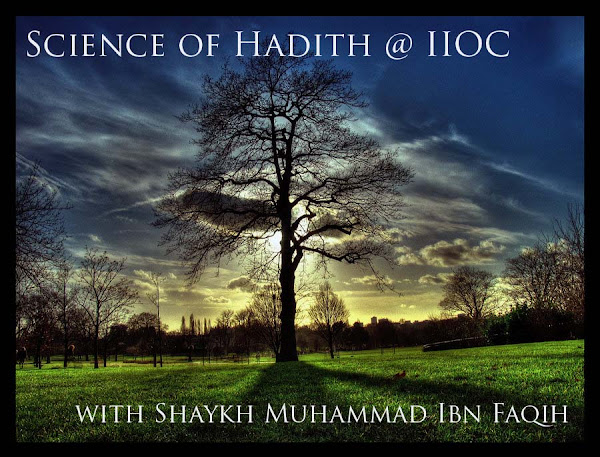Announcements:
1. Get ready for a new class memorization competition!
2. Sh. Faqih is going to get his ijazah from Sh. Walid in 25 ahadith, who’s sanad traces back to the Prophet Muhammad (saws).
1. M. Mana can find these 25 hadiths
3. Sh. Bakr Abu Zaydi (supreme scholar of Saudi Arabia) passed away last week @ the ages of 63. One of his writings was an article (not published) that was sent to one of the shuyukh in Saudi Arabia who had very harshly criticized Sayyid Qutb. In this article/letter, he was defending Sayyid Qutb, and it was amazing. He was also known for his stance regarding anyone that attacked du`a’ and the scholars and issues as such.
4. Dr. Salih al-Salih passed away in the masjid of the Prophet (saws).
May Allah (swt) give them both jannah and compensate them with their efforts, and replace the ummah with people who are more knowledgeable than them.
Mutawatir
Two types of tawatur:
1. Tawatur lafDhi (literally) – everybody reported the same exact wording (ex. Qur'an)
2. Tawatur ma`nawiyy (in meaning) – different versions of the statement, but the meaning is the same.
Three Conditions for a mutawatir hadith:
1. That it be narrated by a large number of people.
2. That this number be found at every level of the isnad.
3. That it is impossible that they could have gathered together upon a lie.
AaHaad
1. Maqbul (accepted) – if this hadith can most likely be attributed to the prophet (saws), then it is accepted and to be applied.
1. Sahih
1. Sahih li dhatihi (authentic in and of itself)
2. Sahih li ghayrihi (authentic by another hadith) – a hadith in this section consists of one weak hadith, and one strong hadith that supports it.
2. Hasan
1. Hasan li dhatihi (sound in and of itself)
2. Hasan li ghayrihi (sound by another hadith) – the hadith about divorce being the most hated halal act.
2. Mardud (rejected) – if this hadith cannot be attribute to the prophet (saws), then it is rejected. It is not to be accepted as evidence nor is it to be acted upon.
1. Da`if (weak)
2. MawDu` or Makdhub (fabricated; forged) – this is NOT a hadith, it is abrogated
Sahih
It is a hadith that has a chain of narrators that is connected through just and precise narrators from the beginning to the end, not having discrepancies or any hidden defects.
There are five conditions to classifying a hadith as sahih:
1. ittisal al-Sanad – that is that the isnad is connected; that every one of its narrators heart it directly from the person he is narrating from, from the start of the isnad to the end of it.
2. al-`Adalah – that all of its narrators are just (`adl). In order for one to be considered just, they must be:
1. Muslim
2. Of age (balaghah)
3. Sane (`aqil)
4. Not an open sinner (fasiq)
5. Not have bad manners and habits (makruh al-Muru’ah)
These conditions are to be applied to everyone except the sahabah because their credibility has been already established by Allah (swt) and Prophet Muhammad (saws). The only thing that will come up with speaking of the sahabah is if they are actually a sahabi or not.
3. DabT – precision; each one of the narrator must be a DabiT (precise).
1. DabT al-Sadr (precision of the heart) – that he memorizes it correctly and transmits it as he heard it and that he understands it if he is reporting its meaning.
2. DabT al-Kitab (precision of writing) – that he correctly writes it down, preserves it and makes sure that it is passed on correctly
Scholars check on precision when he receives the hadith and then again when he transmits the hadith. In addition, they compare it against the transmission of someone else. They also look at the narrator’s record – was this person known for their memory?
à 1-3 have to do with isnad
à 4-5 have to do with matn
4. `adam al-Shudhudh (lack of discrepancies) – shudhudh here means when the reliable narrators contradict the words of those who are more reliable than him.
5. `adam al-`Illah (lack of hidden defects) - Non apparent while isnad appears to be solid. ex: hidden gap in the isnad.
Rulings of Sahih Hadith:
1. Must accept hadith
2. Must act upon hadith - according to the consensus of the scholars.
Levels of Authenticity:
1. Both Bukhari and Muslim agreed upon.
2. Only Bukhari agreed upon.
3. Only Muslim agreed upon.
4. Fulfilling the conditions of Bukhari and Muslim but not recorded by them.
5. Fulfilling the conditions of Bukhari but not recorded by him.
6. Fulfilling the conditions of Muslim but not recorded by him.
7. Authenticated by others but not following the conditions of Bukhari and Muslim.
A compilation of notes taken by students of knowledge in Shaykh Muhammad ibn Faqih's Science of Hadith class at the Islamic Institute of Orange County (IIOC).
Class Information
Every Wednesday evening after Maghrib prayer.
(For exact Maghrib prayer timings please refer to www.masjidomar.com)
(For exact Maghrib prayer timings please refer to www.masjidomar.com)
Homework/Exam
The final exam for the class was Wed May 14th. If you were unable to take the exam the re-take will be Wed May 21st in sha' Allah.
Textbook
"An Introduction to the Science of Hadith" by Dr. Suhaib Hasan

No comments:
Post a Comment